Heavy tank KV-85
This tank was developed in May — July of the 1943 of the Design Bureau of Experimental Plant No. 100. The main reason for the commencement of work on the combat vehicle was the appearance of a new heavy tank “Tiger” by the enemy. The KV-85 tank adopted the Red Army 08.08.1943 and was mass-produced by the Chelyabinsk Kirov Plant right up to October 1943. The tank was discontinued in connection with the transition of the Chelyabinsk Railway Plant to the production of more advanced heavy tanks EC-1. In all, XK NUMX KV-148 tanks, actively used in 85 combat operations, were built at ChKZ. The tanks sent to the front were lost or written off in 44 — 44. So far, only one authentic KV-45 tank and one experienced KV-85 tank have been preserved, in which the standard 1-millimeter cannon has been replaced with an 76-millimeter gun.
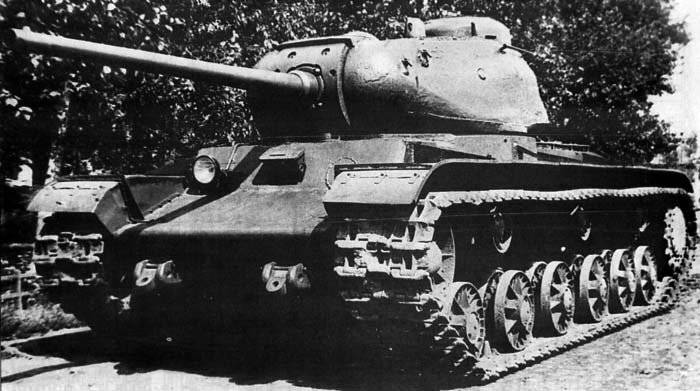
History create
The appearance at the German troops at the end of 42-th - the beginning of the 43-th heavy tank "Tiger" overnight made the Soviet heavy tanks KV-1 and KV-1 ("speed" modification) obsolete. Impenetrable by the German anti-tank and tank cannons in 1941 and the beginning of 1942, the KV armor for the Tiger cannon was not particularly difficult. At the same time, the 76-millimeter cannon ZIS-5 installed on the KV could penetrate only the Stern and side armor of the "Tiger" at a distance of no more than 200 meters. Under these conditions, the work on the development of new artillery armament models and a heavy IS tank for the Red Army, which will be able to penetrate the armor of the Tigers, was forced. According to the results of the shelling of the "Tiger", which fell into the hands of Soviet designers, it turned out that its frontal armor at a distance of up to 1 thousand meters is penetrated by projectiles of an 85-mm anti-aircraft gun. 1939 (52-K). In this regard, 5 of May 1943 of the year at a meeting of the State Defense Committee (State Defense Committee) adopted a resolution № 3289 "On strengthening art. armament of self-propelled units and tanks ". In this resolution, artillery and tank designers were given the task of developing self-propelled and tank 85-millimeter cannons with anti-aircraft ballistics. It was assumed that these guns will be installed in the KV-1 standard tower as well as on the new IS tank.
The TsAKK (Central Artillery Design Bureau), headed by V.G. Grabin and the Artillery Plant Design Bureau No. 9, leader F.F. Petrov. These teams tried to put into service precisely their structure and their heads many times sent letters to higher authorities containing accusations addressed to "competitors", as well as answers to certain technical or organizational questions. Despite this, by 14 June 1943, both teams presented their tools for mounting on pilot tanks. TsAKKB developed on the basis of 76-millimeter tank gun ZiS-5 85-millimeter cannon C-31. This was done by imposing on the cradle of a serial gun 85-millimeter stem group. The design bureau of the plant No. 9 used the design of its 85-mm self-propelled gun D-5С, the lifting mechanism and the bolt of which was taken from the serial tank 76-millimeter gun F-34.
K 20.07. 1943. Experimental Plant No. 100 assembled two experimental KVs, which were armed with these tools. The first was the “238 Object”, which is also called the KV-85G. This machine fully complied with the TZ - with the KV-1 with a standard turret on the 1535 pursuit of millimeters, the 76-mm ZiS-5 cannon was replaced with the X-NUMX-millimeter C-85 gun developed in TsAKB. The second experimental tank, the KV-31 (“85 Object”), was built on its own initiative by the designers of the Chelyabinsk Kirov Plant and Plant No. 239 under the guidance of J.Ya. Kotin. Since there was only a tower from the IS tank (the hull was not ready yet), it was installed on the KV-100s chassis. At the same time, the diameter of the lower shoulder strap of the roof of the combat compartment was increased from 1 millimeters to 1535 millimeters. This operation was technically difficult, since the diameter of the shoulder strap was larger than the width of the roof of the crew compartment. The solution was the expansion of the turret box by welding the armored cylindrical inserts under the protruding portions. Since there was no second C-1800 for armament of the “239 Object”, it was equipped with the X-NUMX-mm D-31-cannon developed in the design bureau of plant No. 85. The KV-5, along with a pair of prototypes of the IS tank, underwent factory tests, the KV-9G did not participate in them - it was clear that it would not pass because of the tightness of the fighting compartment. On tests KV-85 85 passed kilometers at an average speed equal to 85 km / h. Since the Red Army was very much in need of new tanks, these tests were counted as state. On August 284,5, the State Defense Committee, even before the end of the tests, adopted a decree number 16,4 on the adoption of the KV-8 into service and the start of their mass production at ChKZ. The first serial KV-3891 a few days later left the assembly lines of the plant.
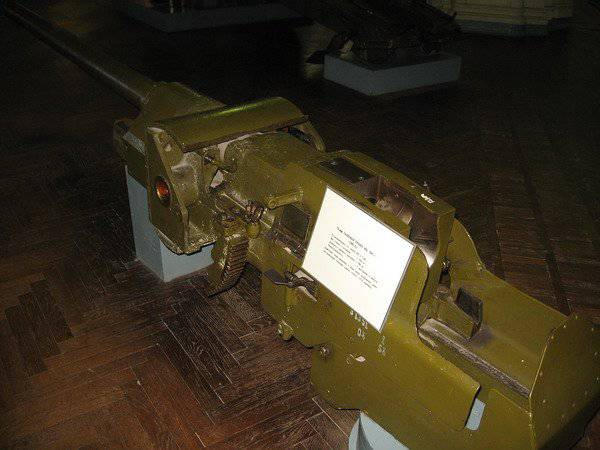
The D-5T cannon during the tests that took place at the Gorokhovetsky artillery range from 21 to 24 August also demonstrated its advantages over the C-31. All four experimental tanks, the KV-85, KV-85G and two prototypes of the IC, took part in these tests. D-5T after the shot was less vibrated, there were no bulky balancing weights, it had smaller dimensions, it was easy to maintain and durable. However, this had to be paid by using in its design a large number of small parts with high demands on their machining and tolerances. As a result, the D-5T gun was produced in small series, which did not allow to install this gun on all new T-34-85 medium tanks. Therefore, for the new machines it was necessary to develop a new more technologically advanced 85-millimeter cannon ZiS-C-53 with identical ballistics.
Winemaking
The first serial KV-85 was built at the pilot plant number 100, and the remaining 147 machines were built by ChKZ. For the construction of the first cars used reserve armored hulls for tanks KV-1, in connection with which it was necessary to brew holes for the ball installation of course machine gun and make in the turret box cutouts for advanced turret towers. In the design of armored hull subsequent series of machines made the necessary changes. In the production of ChKZ KV-85 tank was three months, in the period from August to October 43-g. In August, 22 machines were built, in September and October - on 63. Small volumes of supplies of X-NUMX-millimeter D-85 guns, as well as a great need for them to arm the T-5-34 and EC-85 tanks, caused the KV-1s in parallel with the KV-85 tanks in August. In November, the 1 of the highest priority was assigned to the production of IS tanks, and the KV-43 tanks were completely removed from production.
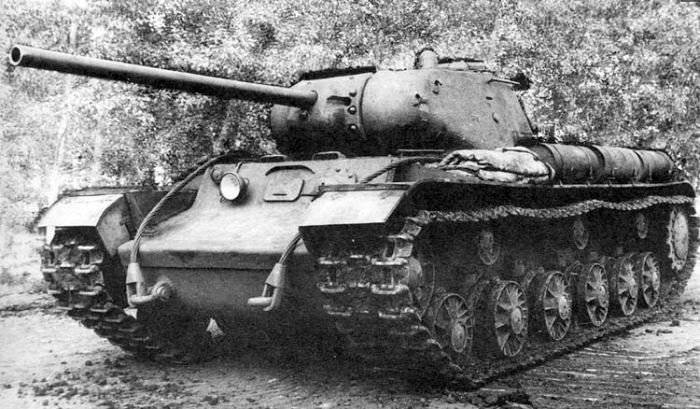
Description of construction
At its core, the KV-85 was a transitional model between the KV-1 tanks and the EC-1. The KV-1 heavy tank KV-85 borrowed most of the details of the armored hull and the entire undercarriage, and from the EC-1 - the tower and gun. The changes concerned only the armored elements of the podbash box - for the KV-85 they were made anew for the installation of a new, more dimensional tower having millimeters 1800 shoulder straps. The tank had a classic layout, the same as all other serial Soviet medium and heavy tanks of the time. In the armored hull consistently from the bow to the stern were located: the separation of control, combat and engine-transmission compartment. A mechanic-driver was housed in the department of control, the workplaces of the other three crew members were located in the fighting compartment that united the tower and the middle part of the armored hull. In the same compartment located gun, ammunition, as well as part of the fuel tanks. Transmission and engine mounted in the stern of the tank.
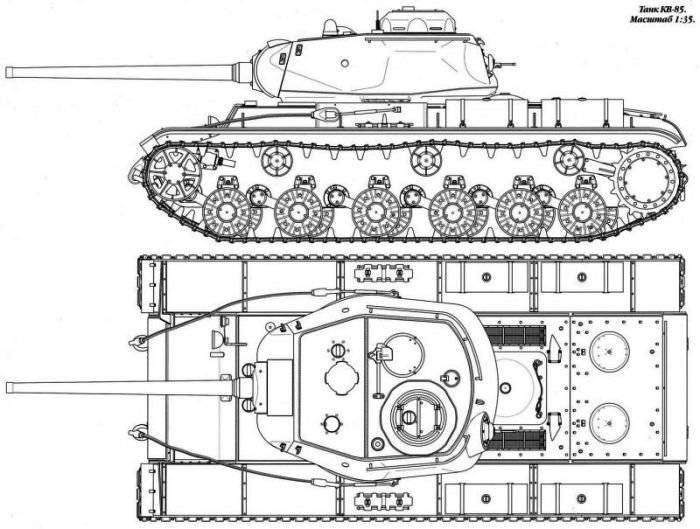
Electric equipment
In the KV-85, the electrical wiring was single-wire; the armored hull of the tank served as the second wire. The exception was the emergency lighting circuit, made by two-wire circuit. The power sources with an operating voltage of 24 B were a GT-4563A generator with a relay-regulator PPA-24 (power 1 kW) as well as four series-connected 6-STE-128 batteries (total capacity 256 Ah). Electricity consumers were:
electric motor turning the tower;
internal and external lighting of the machine, the lighting of the scales of measuring instruments and sights;
signaling circuit from the landing to the crew of the tank and the external sound signal;
instrumentation (voltmeter and ammeter);
electric trigger gun;
tank intercom and radio station;
the electrician of the motor group included the starter CT-700, starting relays PC-400 or PC-371 and so on.
Sights and surveillance equipment
The workplace of the loader and the commander's hatch were equipped with MK-4 periscopic instruments, which allow monitoring the environment from inside the machine (2 total). In the commander's turret there were five viewing slots covered with protective glasses. During the battle, the driver led the observation using a viewing device with triplex, protected by an armored valve. This viewing device was installed in an armored jacket plug placed on the frontal armor plate along the longitudinal center line of the tank. This hatch in a calm atmosphere was pushed forward, giving a convenient direct view from the workplace of the driver.
The KV-85 tank was equipped with two gun sights - a periscopic PT4-15 (for firing from closed positions) and a telescopic 10Т-15 (used in direct fire). The head of the periscope sight was protected by a special armor cap. The scales of the sights were equipped with illumination devices, which allowed firing in the dark. The stern DT machine gun was completed with a four-time PU sight from a sniper rifle.
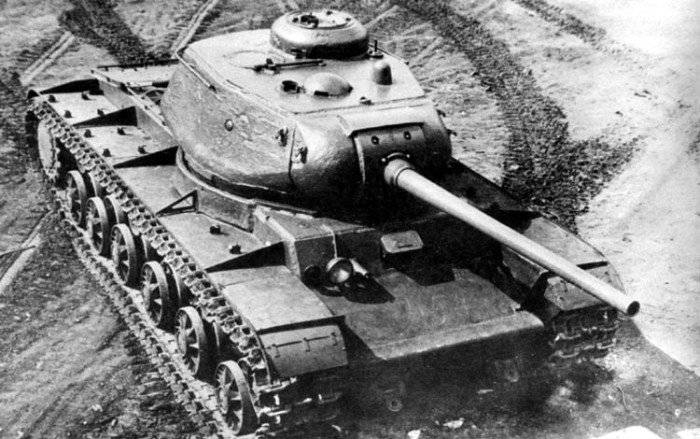
Means of communication
The communication equipment of the KV-85 tank was the 9Р radio station (or 10Р, 10РК-26), as well as the intercom system TPU-4-Bis, designed for four subscribers.
The 10P radio station (10РК) was a set consisting of a transmitter, a receiver, and wormformers (a single-pole motor-generator) for their power supply, which were connected to the on-board power network.
10P was a simplex lamp heterodyne shortwave radio station operating in the 3,75-6 MHz band (wavelengths - 50-80 meters). Communication range in the voice (telephone) mode in the parking lot reached 25 km, while driving and it decreased slightly. A large communication range could be obtained in telegraph mode, by transmitting information with a Morse key or other discrete coding system. Frequency stabilization was carried out using a removable quartz resonator. Smooth adjustment was absent. The 10P radio station provided communication on a pair of fixed frequencies; to change the frequencies used another quartz resonator, consisting of 15 pairs included in the kit radio.
10РК was a technological improvement of the radio station 10Р. The new radio station was simpler, and its production is cheaper. The 10РК became possible to smoothly switch operating frequencies, the number of quartz resonators was reduced to 16. Communication range has not changed significantly.
The TPU-4-Bis tank intercom made it possible to negotiate among the crew members even under conditions of high noise and connect a headset (laryngophones and headphones) to the radio for external communication.
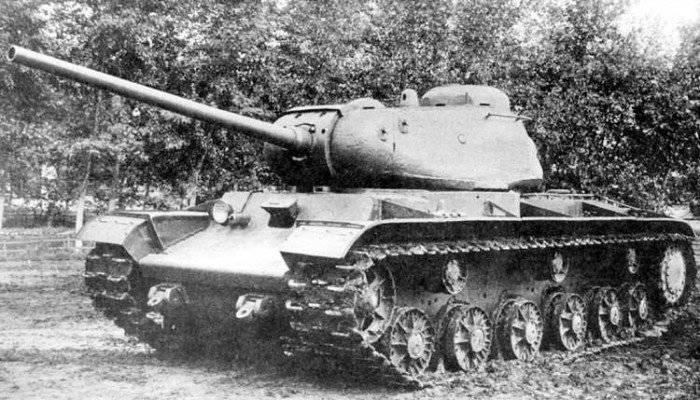
Engine
Tanks KV-85 was equipped with a V-shaped four-stroke 12-cylinder diesel engine B-2K power 441 kW (600 hp.) The engine was started by starter CT-700 power 11 kW (15 hp.) Or compressed air which was in two tanks with a capacity of 5 liters placed in the fighting compartment. The layout of the KV-85 was dense, with its main fuel tanks (capacity 600 — 615 liters) located not only in the engine-transmission, but also in the fighting compartment. The tank was also equipped with four additional external fuel tanks (total capacity 360 liters) that were not connected to the engine fuel system.
Трансмиссия
The tank had a mechanical transmission consisting of:
multi-disk main friction dry friction ("steel on Ferodo");
a four-speed gearbox with a multiplexer (8 front and 2 reverse gear);
two multi-disk clutches ("steel on steel");
two onboard planetary gearboxes.
transmission control drives are mechanical.
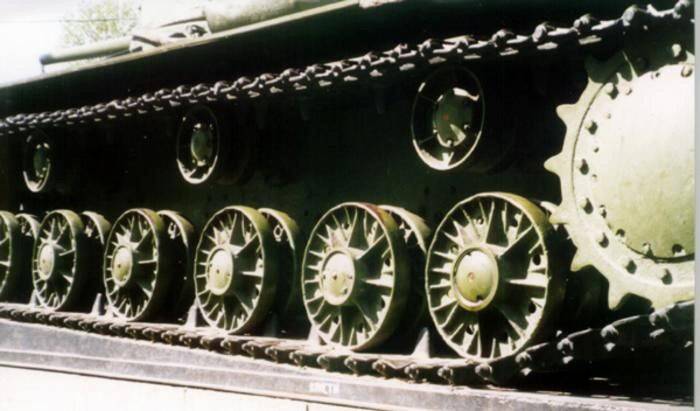
Chassis
The chassis of the KV-85 was completely identical to the chassis of the KV-1. Suspension - individual torsion bar for each of the 6 duo-pitch solid cast wheels (diameter 600 millimeters) on each side. To the armored hull opposite the support rollers, the travel limiters of the suspension balancers were welded. The drive wheel, which has a removable toothed crown gear, was installed at the back. Sloths located in front. The upper branch of the caterpillar was supported by three (on each side) small, solid supporting rollers. The mechanism of the caterpillar tension is screw. The caterpillar consisted of 86 — 90 single-strand tracks. Track width - 608 millimeters.
weaponry
The main armament of the KV-85 tank was the X-NUMX mm D-85T gun. The gun was installed in the axle tower and was balanced. The D-5T cannon tower was also balanced: the center of mass was on a geometric axis of rotation. The vertical pointing angles of the D-5T gun ranged from −5 ° to + 5 °. When the tower was in a fixed position, the gun could be induced in the horizontal plane in a small sector (the so-called "jewelry" tip). The shot was made by manual mechanical descent or electric descent.
Ammunition of the gun consisted of 70 shots of unitary loading, which were placed along the sides of the fighting compartment and in the tower. Compared with the "assortment" of ammunition 85-millimeter anti-aircraft gun 52-K, ammunition KV-85 was less diverse. Ammunition included:
armor-piercing unitary shot (mass 16 kg) having an armor-piercing tracer thick-headed projectile, with a ballistic tip BR-365 (tip weight - 9,2 kg, explosive - ammotol or trotyl - 164 g) and charge G-365 (weight from 2,48 to 2,6 ). Initial speed - 792 meters per second;
armor-piercing unitary shot (weight 16 kg) having an AR-365K armored-piercing sharp-headed projectile (weight of the 9,2 kg projectile, explosive ammotol or trotyl - 48 g) and charge of the X-365 (weight from 2,48 to 2,6 kg). Initial speed - 792 meters per second;
armor-piercing unitary shot (weight 11,42 kg) having a sub-caliber projectile of the reel type BR-365P (weight 5,0 kg) and charge G-365 (weight from 2,5 to 2,85 kg). The initial speed of 1050 meters per second;
fragmentation unitary shot (mass 14,95 kg) having an O-365 projectile (mass 9,54 kg, explosive mass — ammotol or TNT — 741 g) and charge G-365 (mass 2,6 kg). The initial speed is 792 meters per second.
O-365 fragmentation shells had a large number of options. In the case of equipping some fuses, they could be used as high-explosive.
According to Soviet data, the BR-365 armor-piercing projectile at a meeting angle of 90 is hail. 111-mm armor plate penetrated at a distance of 500 meters; at the 1000 distance of meters under the same conditions, an armor plate thickness of 102 millimeters penetrated. A sabot projectile BR-365P along the normal pierced the armor plate 140 mm of thickness at a distance of 500 meters. At an angle of meeting 30 ° relative to the normal, the BR-365 projectile pierced the armor of millimeters 98 to 600 meters with 1000-83 millimeters when shooting at close range.
On the KV-85, three DT machine guns of caliber 7,62 mm were installed: paired with a gun, fixed course and stern on the rear of the tower in a ball joint. Ammunition for machine guns DT consisted of 3276 cartridges. These machine guns were installed in such a way that, if necessary, were removed and used outside the machine. In addition, the crew had F-1 hand grenades for self-defense, sometimes the crew members were supplied with a pistol for firing a signal rocket.
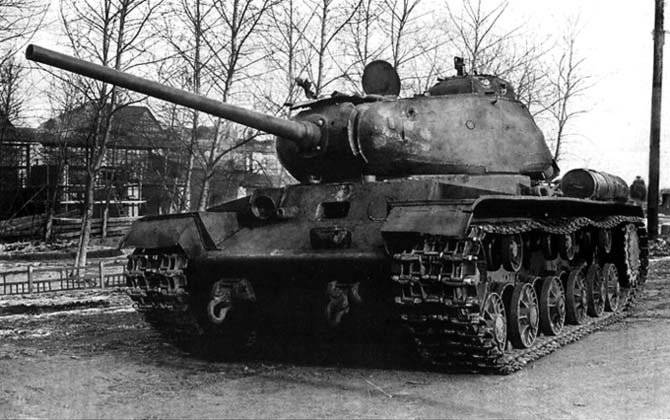
Tower and armor
The armored hull of the KV-85 tank was welded from rolled armored plates 20, 30, 40, 60 and 75 millimeters thick. The armor protection is counter-differentiated. Armored plates of the frontal part of the tank were installed at rational angles. The streamlined tower is an armored casting of complex geometric shape. The thickness of the side armor was 100 millimeters, to increase the projectile resistance, it was located at an angle. The frontal part of the tower with an embrasure was formed by the intersection of four spheres and was cast separately. With the rest of the armor was connected by welding. The gun mask is a cylindrical segment of a rolled-up curved armored plate, in which there were three openings — for a cannon, a sight, and a coaxial machine gun. The tower was installed on a shoulder strap (diameter 1800 millimeters) in the armored roof of the crew compartment. For fixing, captures were used that prevented stalling when overturning or strong roll of the tank. The surface of "contact" of the upper shoulder strap of the armored hull and the lower shoulder strap of the tower was sunk into the roof of the fighting compartment. This eliminated the jamming of the tower during the shelling. The epaulettes of the tower for firing from closed positions were marked in thousandths.
The driver was located in the front of the tank hull in the center. Since the installation of a more dimensional tower did not allow the workplace of the radio operator-gunner to be placed in the control department, he was generally excluded from the crew. The hole made in the frontal part for the ball mounting of the course machine gun was welded, and the machine gun itself was placed in a fixed mount to the right of the driver. The innocent fire from this machine gun led the driver-mechanic, pressing the trigger of the electric trigger mechanism located on the control lever. This constructive solution was used on subsequent Soviet heavy IS tanks, but later on course machine guns were completely abandoned due to the low effectiveness of un aimed fire and the weakening of frontal booking. Three crew members were stationed in the turret: the jobs of the tank commander and the gunner to the left of the gun, the loader - to the right. The commander had a casting observation turret with thick armor up to 82 millimeters. For the entrance / exit of the crew, hatches in the turret were used: a double-wing round hatch of the commander's turret, a single-wing round loader hatch. In the case there was a bottom hatch serving for emergency escape of the tank and several hatches, technological openings and hatches for loading ammunition, access to the units and components of the machine, the neck of the fuel tanks.
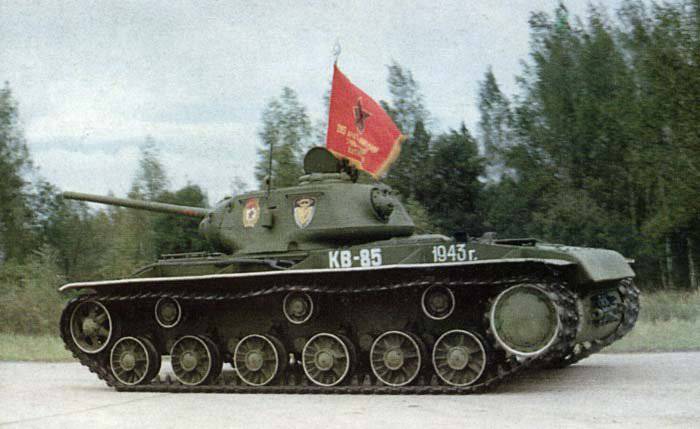
Machines created on the basis of KV-85
The installation on the chassis of the HF tower from the IC opened up the possibility of installing more powerful artillery systems on the chassis. For example, at the end of 43, experienced tanks KV-122 and KV-100 were built. The KV-100 was armed with the X-NUMX-millimeter cannon C-100, and the K-B-34 with the X-NUMX-millimeter cannon D-122T. Since the new heavy tank IS-122, which has a much more advanced armor protection, was launched into mass production, the issue of accepting these vehicles for the Red Army did not even arise.
Combat use of the tank KV-85
Since September 43 of the KV-85 tanks began to enter service with the OGvTTP. Approximately at the same time, however, with some delay, which was required for the formation of new parts, as well as their sending to the front, the tanks entered the battle, mainly in the southern directions. Since the KV-85 was inferior in its characteristics to the German heavy tanks, and their armor was not sufficient for that time, the battles in which the KV-85 participated went with varying success, and the result was largely determined by the crew proficiency.
The main purpose of the KV-85 is to break through the enemy’s pre-fortified defensive lines, where the main danger was anti-tank self-propelled and towed guns, engineering and mine-blast barriers, and not enemy tanks. Despite the insufficient booking, the KV-85 mainly fulfilled its task, but the price was a significant loss. The small volume of production, as well as the intensive use of KV-85 tanks, caused the fact that by the fall of 44, due to irretrievable combat losses and write-offs of tanks of this type, no more. There is no information about the combat use of these tanks after this period.
There are several references to the confrontation of the KV-85 and enemy tanks. For example, from 20 to 23 in November, the Thirty-fourthth OGvTTP Twenty-Eighth Army of the Fourth Ukrainian Front as part of 20 KV-85 tanks with the support of 9 and SU-152 OSTAP in the village of Yekaterinovka attacked German positions. In the course of these battles, the Forty-third OGvTTP lost 8 tanks KV-85 (as a result of which it was not known), destroying 5 German PzKpfw IV, as well as towed guns and infantry of the enemy.
However, the KV-85 in the hands of tactically competent and experienced tankers was a formidable weaponable to successfully destroy the new German armored vehicles. An excerpt from the “Report on the hostilities of mechanized and armored troops of the Thirty-eighth Army in the period from 24 to 31 in January of 44,” on the Seventh Separate Guards Heavy Tank Regiment (OGTPP) shows:
"In accordance with the combat order of Staff of the Seventeenth Corps, remaining 5 ACS and tanks (2 SU-122 and 3 HF-85) to 7.00 28 January 1944 years occupied the farm to them. Telman perimeter defense in readiness to repel the attack of enemy tanks in the direction Rososhe, state farm "Bolshevik", state farm "Kommunar". 2 anti-tank guns and 50 infantry took up defensive positions near tanks. The enemy tanks accumulated south of Rososhe. In 11.30, the T-15 and 6 small and medium tanks were used to oppose small and medium tanks of small and medium tanks T-13 and XNUMX small and medium tanks. infantry from the south, attack on the farm Thalmann.
Taking advantageous positions, because of stacks and buildings, letting the enemy at a direct shot distance, our self-propelled guns and tanks opened fire, disrupting the enemy’s battle formations. At the same time, 6 tanks (3 of which were "Tiger") were destroyed and destroyed before the infantry platoon. To eliminate the breakthrough of the German infantry from the grouping tank KV-85 was allocated under the command of Art. Lieutenant Kuleshov, who carried out the task with caterpillars and fire. To 13.00 of the same day, enemy troops, not daring to attack the Soviet regiment in the forehead, bypassed the Telman State Farm, completing the encirclement of the Soviet group.
The battle of Soviet tanks surrounded by superior forces is characterized by extraordinary heroism and skill of our tank crews. A tank group (commander of a company of guards senior lieutenant Podust) defending the state farm Telman did not allow enemy troops to transfer forces to other areas. The tanks, often changing their firing positions, aimed the enemy tanks, and the Su-122, went into open positions, shooting the infantry, which was planted on transporters and moving along the road to Ilintsy, blocking the freedom of maneuver to enemy tanks and infantry. In addition, by their actions they contributed to the release of parts of the Seventeenth Rifle Corps from the environment. Surrounded by tanks continued to fight until 19.30, although the infantry by this time the state farm was not. Intensive fire, maneuver and the use of shelters allowed almost no casualties (except for two wounded), inflicting significant damage to the enemy in technology and manpower. During January 28 1944 was destroyed and destroyed tanks "Tiger» - 5 pieces, T-4 -. 5, T-3 - 2, armored personnel carriers - 7, antitank guns - 6, machine-gun point - 4, infantry - up to three platoons, horse carts - 28.
In 20.00, the group made a breakthrough from the environment. After a firefight, the tank group went to 22.00 in the location of the Soviet troops. At the same time, the 1 SU-122 was lost and burned. "
According to Polish data, 5 KV-85 tanks in 1945 were handed over to the People’s Army of Poland, where in the first post-war years they used them as training.
Tactical and technical characteristics of a heavy tank KV-85:
Combat weight - 46 tons;
Crew - 4 person;
Body length - 6900 mm;
Length - 8490 mm (with a gun forward);
Case width - 3250 mm;
Height - mm 2830;
Clearance - 450 mm;
The main armament is the X-NUMX-mm gun D-85T;
Auxiliary armament - 3 machine gun DT DT caliber 7,62 mm;
Ammunition of the main gun - 70 pieces; Ammunition of auxiliary weapons - 3276 pieces;
Engine make - B-2K;
Engine type - diesel;
Engine power - HP 600 .;
Maximum speed - 42 km / h;
Power reserve - 330 km;
Specific power - 13 l. s./t;
Obstacle obstacles:
Vertical wall - 0,8 m;
Moat - 2,7 m;
Overcoming ford - 1,6 m;
Rise / roll - 40 hail
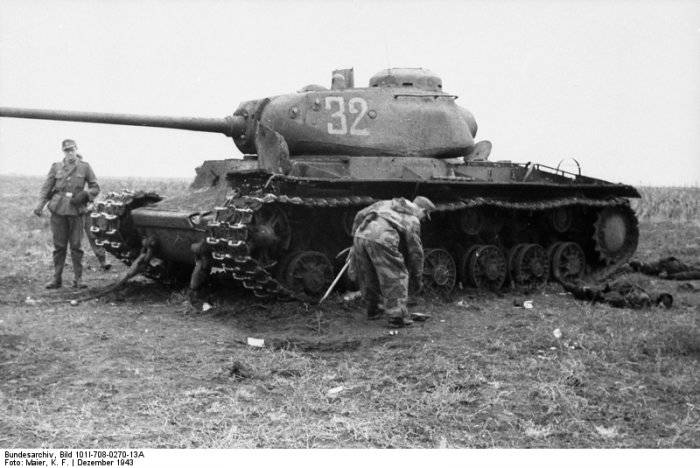
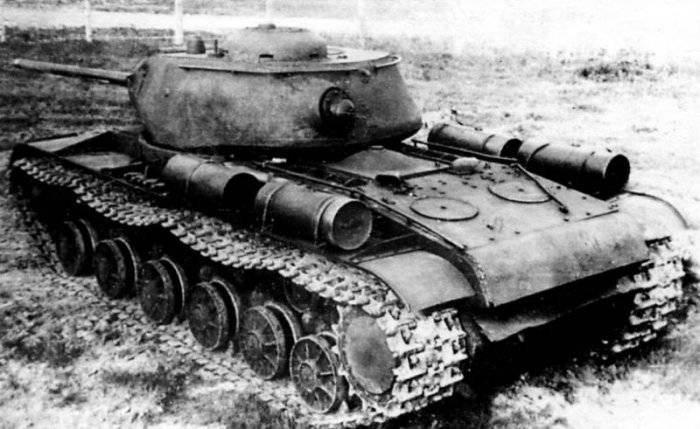
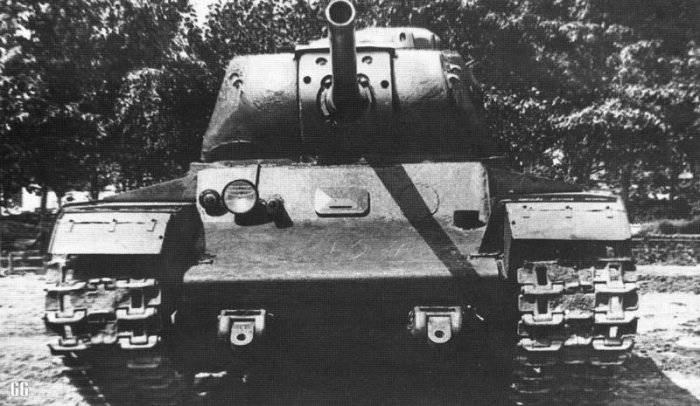
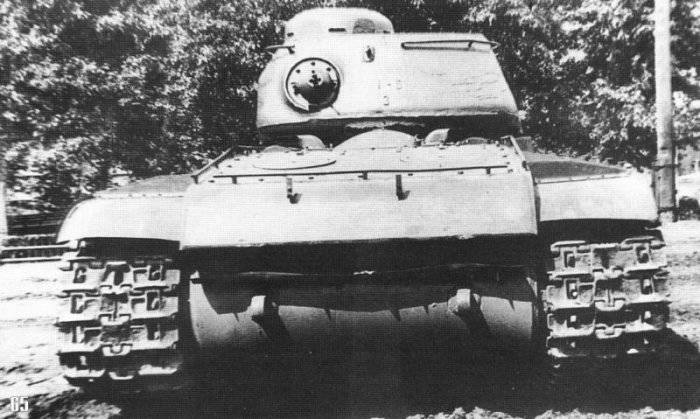
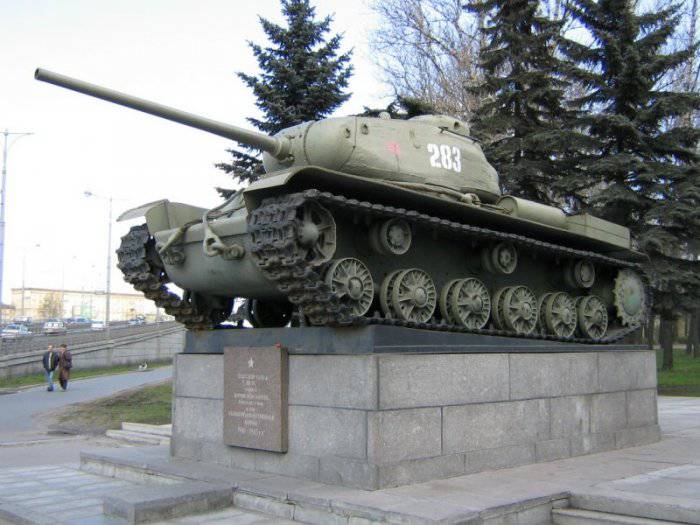
Information